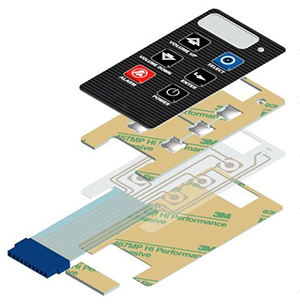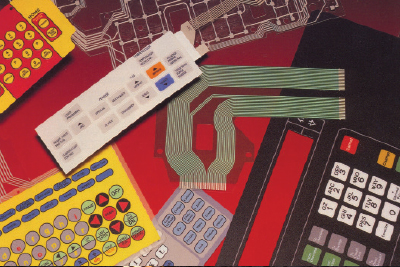Our suppliers specialize in the production of membrane switches (tactile and nontactile) and silicone rubber products (IMD lenses, PR button, silicone rubber parts, silicone wristbands, etc.) designed for applications that require a superior level of reliability, incredible strength and long service life.
What is a membrane switch.

It is a user interface device, composed of several layers, used as a switch to turn a device on/off.
Unlike mechanical switches, which are generally constructed from copper and plastic, membrane switches are printed circuit boards on film, composed of several layers laminated together.
The layers of a basic membrane switch construction are: a membrane overlay, a spacer, a print circuit, a back adhesive, and a tail filler.
Depending on the environment and application requirements, the construction may be different.
For example, if shielding is required, a two-circuit membrane switch would be the best choice.
TACTILE MEMBRANE SWITCH
Tactile membrane switches have a unique tactile feel, partly generated by the metal dome.
- Impeccable click response
- Rapid click
- High performance in high-temperature applications
NONTACTILE KEYPADS
Non-tactile membrane keyboards are a perfect solution for applications requiring a thin, flat surface.
- Simple construction and no metal required
- Little or no tactile sensation
- Remarkably cost-effective
CIRCUIT TYPE
We offer membrane switches on two circuit types:
Flexible silver on polyester (PET)
FPC flexible printed circuit board
Conductive silver ink on polyester circuits.
The most common choice because of their low cost.
They may include:
- 5mm connectors
- Side and two-sided circuitry
- Three-color LEDs
- 7 low-profile segments
Keypad with FPC membrane switch
For more stringent environmental requirements, the silver printed circuit board can be replaced with a copper and polyimide (Kapton) construction.
These construction designs offer:
- Advantage over current load capacity
- Better resistance to moisture
- Much higher conductivity than silver on PET
FPCs can have multilayer constructions and allow soldering of active and passive components.
GRAPHICS AND BUTTONS

The graphic overlay is the top layer in the membrane switch assembly, and the overlay is the top visual component on a keyboard.
Overlays can include branding, color design, and logos to support the product.
Our suppliers can offer different finishes to meet your needs, for example: glossy, textured, and anti-reflective.
Embossing, button response, and lighting should be considered when designing the membrane switch keyboard and graphic overlay.
Buttons
Buttons can be embossed as part of the graphic overlay, or soft or hard printed buttons integrated.
- The tactile feel is created by discrete metal domes, or by layers of formed polyester
- The force of button actuation can vary as needed
- A tactile dome switch can be used when an audible click is needed
Embossed tactile graphics
A tactile dome is formed in the graphic layer to create a tactile, raised sensation. Tactile domes are produced to exceed 1 million actuations.
Metal dome
Metal domes are generally the best choice if good tactile response and click feeling is required.
Metal domes are made of Stainless Steel, Nickel plated, gold (Au).
The most widely used four-leg (star) domes are available in a size range of 5 mm-20 mm, a force range of 125-500 gf, and 3,500,000 or >1 million cycles.





